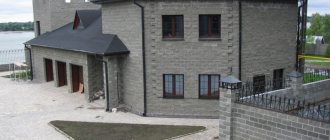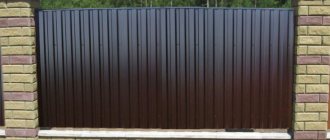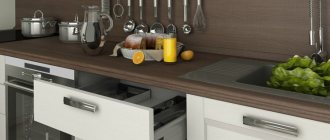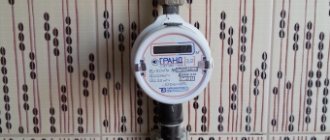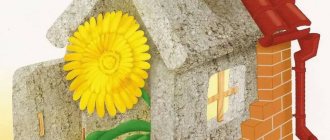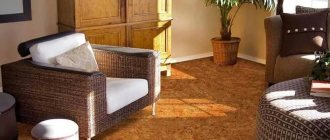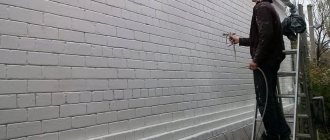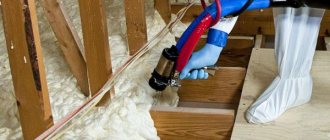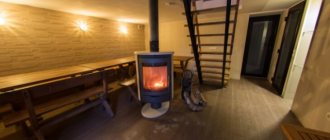Cinder block is a type of artificial concrete stone.
Due to its low cost and availability, it is widely used for wall construction and road construction. Blocks are produced using different types of fillers: slag, crushed stone and sand, the binding material for which is cement.
The more cement and crushed stone a block contains, the stronger it is, but at the same time it has greater thermal conductivity, so these walls need thermal protection.
How to calculate the cost if you decide to build a house from cinder blocks yourself
There is nothing special about budgeting for a cinder block home.
We talked about calculating the amount of wall material, so calculating the cost of building materials for this part of the construction will not be difficult. But remember that, in addition to the walls, you will need to invest in the foundation, roofing, interior and exterior decoration, and necessary communications. You won't find a calculator that will do the full calculation for you. The budget will depend on the prices of materials in the region, the cost of construction services, or, if you are going to do this work yourself, the purchase of the necessary tools.
If you don’t have a plot for a house, add the cost of purchasing it to your total budget
In a word, if you want to estimate future costs, look among your friends and acquaintances for those who have recently mastered a similar construction project. Inquire about turnkey costs from local construction companies. You can safely reduce their amount by a third - approximately how much it will cost you to build such a house with your own hands.
How to choose the thickness of insulation?
The effectiveness of insulation depends not only on the selected material, but also on the thickness of the thermal insulation layer. In order to make an accurate calculation, you need to take into account the totality of the characteristics of the cinder block, insulation, as well as the climatic conditions of a particular region. Therefore, to simplify orientation, we present data based on the long-term experience of builders:
- The optimal level of thermal insulation thickness throughout Russia is 10 cm.
- In the southern regions, a layer of 5-7 cm is sufficient.
For a more accurate calculation, contact a specialist or ask for advice from local construction companies.
Types of material
As mentioned earlier, a material such as cinder block has several varieties, each of which has its own characteristics and rules of application. Let's take a closer look at these products.
Hollow and solid
Both of these block options are in great demand. For example, common solid varieties are most often used in the construction of foundation structures, columns of various modifications and load-bearing foundations. Moreover, hollow blocks are perfect for forming basement floors.
As for hollow blocks, they are usually purchased for the construction of partitions and walls. They have a modest weight, so they do not burden the overall foundation of the home at all.
Decorative
Such cladding materials have occupied their niche in the market quite recently. They are complemented by a special decorative coating, which can be located either on one or both sides of the block. This additional layer can replicate various types of textures (for example, stone or plaster). In addition, in this way it will be possible to protect the blocks themselves from such negative factors as moisture and dampness. If you have chosen decorative materials for construction, then you can refuse the exterior decoration of the building.
Septal
If you have moved on to the construction of partition structures in a block house, then you need to use the specified types of materials. Such specimens are distinguished by the fact that they can be used to build smooth and neat walls, while saving on mortar. It should also be noted that partition cinder blocks are light in weight, and their installation is quick and easy.
Fundamental
Foundation type blocks are also called building stone. These materials have high strength and durability. Over time, such blocks do not shrink significantly and do not collapse, which indicates their increased reliability. If you are laying cinder blocks on a fairly strong and stable base, then you should remember the need to use reinforced concrete tape. Its layer should be at least 1.5 cm.
Experts advise paying attention to the fact that the walls of cinder block foundation structures must be heat- and vapor-insulated with special materials.
Chipped and torn
Not long ago, the building materials market was replenished with original slag blocks that have a decorative surface simulating torn/chipped brick. These options are most often used when finishing various buildings and fences.
Color
There is also a colored version of slag concrete on the market. Fences, gables or pillars are most often constructed from this material. The required shade of this material is achieved at the stage of its manufacture.
Slag blocks differ from each other in their main components.
Slag based
The properties and characteristics of such blocks primarily depend on the properties of the feedstock. This mainly relates to the environmental safety of materials (meaning the presence of toxic substances in their composition). This parameter should be taken into account when choosing slag blocks.
These materials are distinguished by high thermal insulation qualities. As for the service life, it is the same as that of brick. But here you need to start from what kind of filler is present in the material. Slag-based blocks will last a very long time and will not cause problems if they are laid and finished correctly.
Arbolite
Arbolite-based blocks are in great demand today. Such materials are in great demand as they have excellent thermal insulation characteristics. However, such products have one serious drawback - they cannot boast of a long enough service life. Of course, during the manufacturing process, wood concrete blocks can be made more durable, but their environmental friendliness usually suffers from this. Such negative changes are due to the fact that special substances are added to the usual composition, which cannot boast of natural origin.
Expanded clay
Blocks based on expanded clay are rightfully recognized as the safest and most environmentally friendly. Such products are famous for their excellent thermal insulation qualities and durability.
It should be taken into account that the popularity of such blocks is explained not only by their environmentally friendly base. These varieties are lightweight and have multiple voids in their structure. Most experts recommend using these types of cinder blocks to build a house. Currently, more than 50% of homes in Europe are made of similar elements.
Block manufacturing technology
After the mold is ready, we proceed directly to mixing the solution and forming cinder blocks. In many videos on the Internet you can see craftsmen doing this on the street. But, you must admit, the weather can bring surprises in the form of precipitation and then all the work will go down the drain. Another reason to move the process indoors is a flat floor surface. In order for the blocks to dry well, the room must have good ventilation.
The process of making cinder blocks at home using formwork (molds):
- All the necessary components are placed in a concrete mixer or other mixing container in the required proportions. In principle, the process of mixing a solution for cinder blocks is similar to the technology of mixing concrete;
- Before pouring the solution into the mold, its walls are lubricated from the inside with treated machine oil. This is done so that already dried blocks are easier to remove from it;
- the finished solution is poured into the mold. After pouring the solution, the walls of the mold are tapped with a hammer. This allows not only the solution to be evenly distributed, but also all excess air to escape from it. If necessary, the solution is added and the surface is leveled with a spatula;
- to form voids, two glass bottles are evenly inserted into the mold with the solution; after a while they can be pulled out;
- after all necessary manipulations, the form is moved to an open area to dry;
- After 40 minutes, the cinder block will dry and you can disassemble the mold. The side walls, lid and bottom are removed;
- In this form, the cinder blocks are left until completely hardened. This usually takes from one day to four days.
The process of making cinder blocks at home using a vibrating machine:
- as with molds, the solution is first mixed;
- The prepared mixture is poured into the mold, and the machine is turned on for a few seconds. This is necessary for compaction. After turning off the machine, if the solution does not reach the edge of the mold, it is added. Level the top until the edges of the cylinders appear on the surface;
- the machine turns on again for about 10-15 seconds;
- After complete shrinkage of the solution, the form is pressed from above with a special press. The press is lowered and raised 3-4 times until the solution is completely compacted;
- Without turning off the vibration, the mold is removed, and the cinder blocks are left to dry for about a week;
- under the necessary conditions: high humidity and warm air, the cinder block completely hardens within a month. If it is very hot outside, it is necessary to periodically wet the surface of the blocks with water. This will prevent them from cracking.
To obtain a smooth and even surface of the cinder blocks, after removing them from the mold, they are laid on a rubber surface.
Important: in order to avoid deformation or breakage of finished products, they can be stacked on top of each other only after complete hardening.
Application in construction
Use of cinder block in construction
The use of cinder blocks in construction is very diverse and depends on the type of material chosen. For the walls and foundation of a house, it is better to use a solid cinder block, and for the construction of partitions in a house, bathhouse, garage, shed and other utility rooms, hollow blocks are quite suitable. It has also proven itself well as insulation in frame-type buildings. This will be the optimal material for such buildings.
The use of foam blocks in the construction of buildings of various heights is considered optimal, taking into account the economic benefits. Which brand of this material is better for the construction of certain buildings depends on their type.
Blocks are divided into:
- thermal insulation type, from which you can build interior partitions,
- structural and thermal insulation, suitable for low-rise construction and for the construction of partitions,
- as well as a structural type of blocks from which load-bearing walls of multi-story buildings can be built.
The question of which is better for the construction of the required facility, a foam block or a cinder block, must be decided at the design stage of the structure.
What is best suited for a given building should be chosen based on the purpose and characteristics of the building and the planned budget.
- Aerated concrete in construction
- Cinder blocks in construction
- Foam blocks in construction
- Which material is better?
Today, building houses, garages, fences and other structures is not difficult. The market offers a variety of materials for construction that even a non-professional builder can use. Houses are built mainly from brick, wood and no less popular materials, which include cinder blocks, aerated concrete and foam blocks. If everything is clear with brick and wood, then the remaining three materials still cause mistrust. Only a specialist who understands the composition of the given materials and their technical characteristics can answer the question of which is better - brick or cinder block, foam block or aerated concrete.
If before construction the question arises about choosing a suitable material, you should thoroughly study all the materials offered. Let's try to determine: what are the differences between aerated concrete, cinder block and foam block. After all, these seemingly identical materials contain a lot of distinctive features.
APPENDIX 1 Reference
1. Thermal conductivity of concrete stones
| Name concrete | Thermal conductivity of concrete stones, W/(m °C), at average concrete density, kg/m3 (for operating conditions A/B) | |||||
| 1000 | 1200 | 1400 | 1600 | 1800 | 2000 | |
| Tufobeton | – | 0,41/0,47 | 0,52/0,58 | 0,70/0,81 | 0,87/0,99 | – |
| Pumice concrete | 0,30/0,34 | 0,40/0,43 | 0,49/0,54 | 0,62/0,68 | – | – |
| Concrete on volcanic slag | 0,29/0,35 | 0,41/0,47 | 0,52/0,58 | 0,64/0,70 | – | – |
| Concrete based on granulated blast furnace slag | – | 0,47/0,52 | 0,52/0,58 | 0,58/0,64 | 0,70/0,81 | 0,83/0,99 |
| Concrete based on fuel (boiler) slags | 0,38/0,44 | 0,48/0,54 | 0,59/0,65 | 0,72/0,78 | 0,85/0,93 | 0,92/1,08 |
| Expanded clay concrete on expanded clay sand | 0,33/0,41 | 0,44/0,52 | 0,56/0,65 | 0,67/0,79 | 0,80/0,92 | – |
| Expanded clay concrete on quartz sand | – | 0,48/0,55 | 0,63/0,69 | 0,72/0,83 | 0,85/0,9 | 0,99/1,13 |
| Shungizite concrete | 0,33/0,38 | 0,44/0,50 | 0,56/0,64 | – | – | – |
Notes:
1. Operating conditions A and B according to SNiPII-3-79.
2. In table. Table 1 shows the thermal conductivity indicators of a number of concretes used for the manufacture of effective and conditionally effective stones of the SKTs, SKI and SKSh types.
3. When calculating the heat transfer resistance of an external wall made of solid stones, it is necessary to increase the thermal conductivity value of concrete by 3%.
2. Thermal conductivity of whole stones
table 2
| Name of concrete | Thermal conductivity of whole stones, W/(m °C), at average stone density (including cracks), kg/m3 (for operating conditions A/B) | |||||
| 750 | 900 | 105 | 1200 | 1350 | 1450 | |
| Tufobeton | – | 0,31/0,34 | 0,37/0,39 | 0,44/0,49 | 0,51/0,55 | – |
| Pumice concrete | 0,27/0,29 | 0,31/0,33 | 0,34/0,37 | 0,41/0,43 | – | – |
| concrete on volcanic slag | 0,27/0,29 | 0,31/0,34 | 0,37/0,39 | 0,42/0,44 | – | – |
| Concrete based on granulated blast furnace slag | – | 0,34/0,37 | 0,37/0,39 | 0,39/0,42 | 0,44/0,49 | 0,50/0,57 |
| Concrete based on fuel (boiler) slags | 0,30/0,32 | 0,35/0,37 | 0,39/0,42 | 0,45/0,48 | 0,50/0,55 | 0,57/0,62 |
| Expanded clay concrete on expanded clay sand | 0,28/0,31 | 0,33/0,37 | 0,38/0,42 | 0,43/0,48 | 0,49/0,53 | – |
| Expanded clay concrete on quartz sand | – | 0,35/0,39 | 0,41/0,45 | 0,46/0,51 | 0,54/0,58 | 0,65/0,69 |
| Shungizite concrete | 0,28/0,30 | 0,33/0,38 | 0,38/0,41 | – | – | – |
Notes:
1. Operating conditions A and B according to SNiPII-3-79.
2. In table. Table 2 shows the thermal conductivity values of individual effective and conditionally effective stones used for laying external walls.
3. Thermal conductivity values are given for hollow stones with the dimensions and shape of the voids indicated in and. The thermal conductivity of stones made from other types of concrete and with other voids should be determined by thermal testing.
4. When calculating the heat transfer resistance of an outer wall made of whole hollow stones, it is necessary to increase the thermal conductivity value by 10%.
3. Thermal conductivity of longitudinal halves of stones
| Name of concrete | Thermal conductivity of longitudinal halves of stones, W/(m °C), with average density of longitudinal halves (including cracks), kg/m3 (for operating conditions A/b) | |||||
| 820 | 980 | 1150 | 1310 | 1470 | 1600 | |
| Tufobeton | – | 0,33/0,36 | 0,39/0,41 | 0,48/0,53 | 0,90/0,60 | – |
| Pumice concrete | 0,29/0,31 | 0,33/0,35 | 0,37/0,40 | 0,45/0,47 | – | – |
Concrete on volcanic slag | 0,29/0,31 | 0,33/0,36 | 0,40/0,42 | 0,46/0,48 | – | – |
| Concrete based on granulated blast furnace slag | – | 0,36/0,39 | 0,39/0,41 | 0,43/0,46 | 0,49/0,54 | 0,56/0,63 |
| Concrete based on fuel (boiler) slags | 0,32/0,34 | 0,37/0,39 | 0,42/0,45 | 0,49/0,53 | 0,55/0,60 | 0,61/0,68 |
| Expanded clay concrete on expanded clay sand | 0,30/0,33 | 0,35/0,39 | 0,41/0,45 | 0,47/0,52 | 0,54/0,56 | – |
| Expanded clay concrete on quartz sand | – | 0,37/0,41 | 0,43/0,47 | 0,49/0,54 | 0,59/0,63 | 0,70/0,75 |
| Shungizite concrete | 0,30/0,32 | 0,35/0,38 | 0,41/0,43 | – | – | – |
Notes:
1. Operating conditions A and B according to SNiPII-3-79.
2. In table. Table 3 shows the thermal conductivity values of individual effective and conditionally effective halves of stones used for laying external walls.
3. Thermal conductivity values are given for hollow stones with the dimensions and shape of the voids indicated on. The thermal conductivity of stones made from other types of concrete and with other voids should be determined by thermal testing.
4. When calculating the heat transfer resistance of an external wall made of hollow stones, it is necessary to increase the thermal conductivity value by 10%.
No. 1. Cinder block: production features
Slag concrete belongs to the category of lightweight concrete blocks. This material first became known at the beginning of the 20th century, when Nicholas II was building a garage in the Winter Palace. At that time, cinder blocks, however, were made from coal combustion waste - slag, hence the name. Since then, production technology has changed somewhat, and the durability of the first cinder block buildings ensured that the material became quite popular.
Today, cinder blocks are made from cement and sand; clay, lime or gypsum, as well as various plasticizing additives, can be added. The filler is no longer slag, but crushed stone, granite screenings, expanded clay, broken bricks, perlite, broken glass and sawdust. In terms of environmental friendliness and harmlessness to health, the best fillers are expanded clay, sawdust, crushed stone and shell rock. Production is carried out on vibroforming equipment.
If in the 70s, when cinder block began to be actively used in construction, garages, sheds and other utility and utility rooms were built from it, today the advantages of the inexpensive material make it possible to use it for the construction of houses and even industrial buildings.
Step-by-step instructions for creating a mixture
If desired, the mixture can be supplemented with plasticizing additives, but you can do without them.
Plasticizers present in the mixture for cinder block mortar speed up the drying time of the cinder block and also prevent it from collapsing. A building material made from a mixture that contains a plasticizer can be removed from the molds and stored after 6-8 hours.
If the production is small, then all the ingredients can be made manually, without the use of special equipment, but you will need a drill with a special attachment for mixing the components. If you need a large amount of cinder block, then a concrete mixer will come in handy.
- The prepared components in the required proportions are poured into a concrete mixer.
- The bulk mixture is mixed well.
- The required amount of water is poured into the concrete mixer.
- The concrete mixer engine is turned on and the mixture is mixed until it turns into a homogeneous mass.
- The finished mixture is poured into molds.
Features of masonry work
Despite the fact that the materials have similarities, the masonry of each of them has its own characteristics. Let's figure it out. What is the process of constructing a building from slag and gas blocks?
Tips for constructing cinder block buildings
When building using this material, you should follow some rules that will help avoid unpleasant consequences.
They boil down to the following:
- Masonry work should be carried out in the warm season in the absence of precipitation;
- The first row should be on an elevated foundation, more than 0.7 meters high;
- You shouldn’t delay finishing the walls; they should soon be protected from moisture;
- The installation of the roof should also be carried out immediately after completion of the work for the same purpose.
Stages of wall construction:
- The laying begins with setting the corners, which is done using rows. A thread is stretched between them, serving as a guide.
- The most important row is the first; its installation must be approached with all responsibility. The adhesive mixture is applied in a thin layer, using a trowel. After laying three blocks, they must be checked for evenness and, if necessary, adjusted. It is recommended to do this as often as possible in order to eliminate errors.
- Subsequent layers are laid in the same way as the seam is offset. All cracks must be filled with mortar.
Stages of construction of aerated concrete walls
The process of laying aerated concrete blocks is extremely similar to laying cinder blocks.
Let's take a quick look:
- The first blocks are placed in the corners and a thread is pulled between them.
- The first layer is laid on the mortar for better adhesion to the base and strengthening the structure. It is recommended to lay subsequent rows on glue, maintaining a thin layer, in order to reduce cold bridges.
- The base must be level!
- After installing the blocks in the corners, begin laying the entire row. If a gap remains, the block is cut to the required size.
- Adjustments are made using a level and a rubber hammer.
- When laying the first and every 4th row, reinforcement is performed.
- The second and subsequent rows are laid with the seam offset.
- After erecting the wall, it is necessary to install an armored belt.
Machine manufacturing procedure:
- We cut out the walls of the future shape from a sheet of iron. The dimensions of the cut parts must correspond to the dimensions of the future blocks.
- A prerequisite before welding all parts of the form is to check it for symmetry. To do this, it is recommended to first fasten all the parts together using clamps.
- Handles are welded to the finished box on both sides.
- A metal sheet is welded to the bottom of the mold. It will serve as the bottom and hold the solution.
- The voids must be located at least 30 mm from the bottom of the mold. Based on this, we calculate the height of the cylinders and cut the metal pipe into parts equal to this height.
- The bottom of each cylinder is sealed.
- The cylinders are connected to each other by metal plates. Starting from the inner edge of the form.
- To mount the motor, 4 bolts are welded on the outside of the transverse wall.
- The apron and blades are welded.
- To press molds, a plate is made with holes, the diameter of which should be approximately 4-5 mm larger than the diameter of the cylinder. It will serve as a compaction press. The press should fit into the mold without interference up to the level of the stops. Handles are welded to its sides.
- Before painting, the entire structure is cleaned and polished. After this it is covered with paint.
- Upon completion of all work related to the manufacture of the mold, the motor is installed.
Characteristics of aerated concrete
Table of technical characteristics of aerated concrete.
Aerated concrete is also an artificial building stone. It consists of quartz sand, lime and aluminum powder. May also include gypsum and industrial waste, such as ash and slag. However, thanks to a special manufacturing technology, it is environmentally friendly and safe for humans. This is a new generation material that has a number of significant advantages.
- Firstly, as already noted, aerated concrete does not contain impurities harmful to humans and does not emit gases and dust into the environment. That is, it meets all environmental requirements. In this parameter, gas blocks are ahead only of the exclusively natural material – wood. In addition, the blocks themselves do not accumulate fungi, mold or bacteria inside themselves. This means that you will not have to additionally treat the walls with antiseptics.
- Secondly, aerated concrete is very durable, frost-resistant and non-flammable. Its service life is designed for more than 100 years, and over time it does not collapse, but becomes harder and harder. Aerated blocks will withstand more than 200 cycles of freezing and thawing, and since they consist only of mineral components, they do not support combustion.
- Thirdly, this is one of the “warmest” materials. Due to their low level of thermal conductivity, aerated concrete blocks with a thickness of about 40 cm can compete with 0.5 m brickwork. As a result, the cost of heating your home can be reduced by 3 times! In this case, additional thermal insulation is not required.
- Fourthly, despite its strength, aerated concrete is better than other materials, it can be processed with tools, sawed, drilled, and is easy to finish and install. It does not rot or rust, making it possible to very quickly construct not only low-rise residential buildings, but also high-rise public buildings and even industrial facilities.
Well, and fifthly, the price of such a convenient building material allows any builder to become a fan of aerated concrete. This explains its massive popularity: gas blocks are now produced in more than 50 countries around the world, and they are used in an even wider area.
But this material also has its disadvantages. For example, he is afraid of moisture and cracks
Therefore, it is recommended to pay additional attention to waterproofing: line the walls with foam plastic, do not use aerated concrete when constructing basement floors, and avoid excessive contact with the soil
Chemical additives recommended for preparing concrete
3.1. Air-entraining
Saponified wood resin SDO according to TU 81-05-02-78.
Neutralized air-entraining resin SNI according to TU 81-05-75-74.
Foaming agent PO-1 according to GOST 6948-81.
3.2. Foaming
Glue rosin foaming agent based on bone glue according to GOST 2067-80. pine rosin according to GOST 19113-84 and caustic soda according to GOST 2263-79.
Resin-anonine foaming agent based on soap root according to OST 1308.
Alkyl sulfate paste according to TU 30-10755-75.
3.3. Plasticizing
Sulfite-yeast mash SDB according to OST 81-79-71 or TU 81-04-225-73.
Surface-active lye PASH-1 according to TU 6-03-26-77.
Synthetic plasticizing additive SPD according to TU 88-101-253-77
Superplasticizer S-3 according to TU 6-14-29-258-79.
Sodium ethyl siliconate GKZh-10 and sodium methyl siliconate GZhK-11 according to TU 6-02-6978-72.
Polyhydrosiloxane GZhK-94 according to GOST 10834-76.
3.4. Hardening accelerators
Calcium chloride CC according to GOST 450-77.
Calcium nitrate NK according to TU 6-08-867-79.
Nitrite-nitrate-chloride NIHK according to TU 6-18-194-76.
Disadvantages of a cinder block foundation
- The cinder block foundation is heavy. This disadvantage is attributed to the cinder block strip foundation. This type of foundation is difficult to classify as light, since the cinder block itself is the same concrete, but in a combined form with slag, crushed stone, bits and other stone impurities. If we are talking about installing a strip foundation made of cinder blocks, then based on the number of blocks, you should carefully calculate what the weight of the foundation itself will be and what load it will exert on the ground.
- Hygroscopicity. Since the cinder block has a porous structure, it absorbs moisture well, which will come directly from the soil and atmosphere. Moisture in the foundation has a rapid destructive effect on the foundation from the inside. This drawback can be eliminated by ensuring good waterproofing of the foundation. Also, you should not plan a cinder block foundation on soils with high groundwater levels and in areas with high humidity.
- Cold foundation. For the most part, this drawback is noticeable if the basement is made of cinder block. But the longevity of the foundation and any building stone is determined by the number of freezing and thawing cycles - frost resistance. Cinder block is a cold material and its frost resistance is not great from 25 cycles. Therefore, the cinder block foundation should be additionally insulated.
- Not stable on shifting ground. The heaviness and strength of a cinder block strip foundation allows it to be erected only on stable and stable soils. For cinder block foundations, compacted clay soils, mixed rocky-sandy soils, and soils of similar properties are well suited. On loam-type soils, a cinder block foundation can shift under its own weight. And this will lead to cracks and destruction of both the foundation and the entire building. It is not recommended to place buildings with foundations made of this material in areas with high humidity and groundwater close to the soil.
- Does not withstand high loads. It is recommended to erect a building no heavier than 100 tons on a cinder block foundation. But this is often enough to build a full-fledged residential building. If lightweight load-bearing material such as wood, foam blocks and building panels are used for construction, then a cinder block foundation will perform its function well.
- Difficult to install alone. The foundation laying technology itself is simple, but difficulty can be caused by the large weight of the cinder block, which ranges from 18 to 28 kg. When laying the foundation, it is recommended to use a solid, heavy cinder block, the weight of which reaches 28 kg. During installation, cinder blocks must be laid evenly on the mortar along the cord, which will be problematic to do alone. Therefore, laying alone will be tedious and may require the help of helpers if you do the laying yourself.
Why is external insulation better?
Qualified craftsmen advise insulating a cinder block house from the outside, since this option has many advantages:
- Extends the service life of the main structure. External thermal insulation must be protected from external influences. The trim not only becomes a barrier to the insulation, but also to the cinder blocks.
- Saves usable space in living spaces.
- Protects against the formation of dew on the walls of the house, and therefore prevents the appearance of fungus or mold.
- Allows you to save up to 70% of heat. Internal walls accumulate heat and release it back when the air temperature in the room drops.
Useful tips
It is recommended to check compliance with the horizontal level more often. This will prevent the walls from warping. If subsequent wall finishing is not carried out, care must be taken to ensure the aesthetics of the seams between the blocks. They can be decorated with a simple rounded stick, allowing for slight pressing of the seams. This must be done until the solution has completely hardened.
When marking cinder blocks, use colored crayons. They are more noticeable on blocks, as opposed to simple pencils.
Cinder block is quite vulnerable to moisture, so it is highly recommended to plaster it after laying. At the same time, use a reinforcing mesh to prevent the plaster from falling off the walls in the future.
How to build a cinder block house with your own hands: main points
Construction of cinder block buildings is a simple process. Such structures are much faster and easier to build than with conventional brick. The main thing is to make the calculations correctly and follow the general construction rules.
How to calculate the number of cinder blocks for building a house
Savings in construction are achieved not only by using cheap building materials, but also by correctly calculating their quantity. It’s better to buy additional blocks if there aren’t enough of them, than to rack your brains about where to put the extra ones. What indicators are included in the calculation? The first is the thickness of the cinder block wall. It depends on the region of residence. For the south and central Russia, it is permissible to install external walls with a thickness of 20 to 40 centimeters. For northern regions, at least 60 centimeters are required.
The second important indicator is the dimensions of the building (width, length and height of the building)
How to calculate the amount of cinder block in 1 m²: to lay one row you will need 12.5 pieces of standard size blocks. If the wall thickness is 40 centimeters, two rows are required, which means we multiply the number of elements of one row by two - we get 25 pieces. If a 60 cm wall is required, multiply by three.
Even a second grader can calculate the total area of the wall: you need to multiply the length by the height. For example, if the wall of a house has dimensions of 10×4, then we have 40 m² of masonry. Laying in two rows: 40 × 25 = 1000 blocks. Do I need to subtract the area of door and window openings? If you are planning regular, medium-sized windows, do not subtract them from the total area.
Cinder blocks are fragile and break frequently, so consider this a bonus for the fight
How to lay a foundation for a cinder block house
A cinder block house requires a high, moisture-proof foundation. It is necessary to protect the wall material from contact with groundwater. For one-story and two-story buildings without reinforced concrete floors there is no need to make a reinforced foundation.
Cinder blocks themselves are not heavy and do not place an increased load on the foundation, but the base needs to be reinforced in any case
The foundation must stand for at least a month before the construction of the walls begins. Only during this period will the solution completely rise and the base will gain the required strength.
How to properly lay a cinder block on a foundation
Blocks are first placed in the corners on the moisture-insulating layer of the foundation. The correctness of their location is carefully checked by the building level. Only after setting the corners is the cord stretched between them, and the masonry of the walls will be built along its line. In practice it looks like this.
How to build the walls of a house yourself - features of laying cinder blocks
The peculiarity of construction work with cinder blocks is that they can only be carried out in good weather at a temperature not lower than +15°C. To preserve the thermal insulation properties of the material, you need to make seams no thicker than one and a half centimeters and under no circumstances fill the voids in the blocks with mortar. The elements are laid offset by half a stone.
The verticality of the masonry should be constantly checked with a building level
Reinforcement needs to be done in every fourth row. To do this, recesses are made using an electric mill, pieces of reinforcement are inserted, and cement mortar is poured. This technique allows you to make the walls much stronger.
Roofing and interior finishing
An important point in the construction of a cinder block building is the installation of the roof. This must be done as quickly as possible so that rain or snow does not fall on the walls. If for some reason you do not have time to cover the roof before the downpour begins, use at least temporary moisture protection: polyethylene or any other covering material.
It is better to insulate cinder block walls from the outside
In any case, the facade of the building will need decorative finishing. If internal insulation is required, a vapor barrier is first installed, and mineral wool or polystyrene foam boards are installed on top. The walls in such a house can be plastered, covered with plasterboard and OSB boards.
Where are they used?
Slag concrete products have gained popularity among industrial and private developers. The installation location and the tasks to be solved determine the set of properties imparted. The characteristics of cinder blocks determine the proportions and composition of the components. The house can have a foundation and all walls made of cinder blocks. Product modifications make it possible to form external load-bearing and non-load-bearing walls, partitions, opening lintels, chimneys and gas ducts, etc. Products can also form stiffening belts. When using internal reinforcement, floor slabs can be made entirely of slag concrete.
Return to contents
How is it different from other materials?
Currently, block building materials are among the most popular and in demand. Buildings made from them are found with enviable frequency. Today there are many types of blocks, and many users wonder how cinder blocks differ from other options. Let's try to answer this question.
From sand blocks and expanded clay blocks
Sand blocks and expanded clay blocks are made in the same way as cinder blocks. As for their environmental characteristics, here the latter are inferior to sand and expanded clay options, because the raw materials for their production are sand and expanded clay, which boast a clean composition without any chemicals or aggressive substances. Cinder blocks are usually made from various industrial wastes.
From aerated block and aerated concrete
You should also understand how cinder block differs from aerated concrete and gas block. In fact, the latter materials are identical. In their manufacture, an important point is the appropriate chemical reaction, which provides a porous structure. Cinder blocks are made mechanically - using pressing.
Based on the parameters of these products, we can come to the following conclusions:
- cinder blocks are denser, harder and more durable than gas blocks, but are inferior to them in thermal qualities;
- cinder blocks are less frost-resistant than aerated concrete.
From foam blocks
Foam blocks today are in demand materials from which not only houses are built, but also various kinds of outbuildings. These materials are similar to cinder blocks in many respects.
The standard dimensional parameters of cinder blocks when laid are equal to 4-5 bricks, while standard foam blocks can replace as many as 7-8 bricks. However, you need to take into account the fact that the foam block is inferior in cost to cinder blocks. The same cannot be said about its thermal insulation characteristics and weight.
From brick
The lion's share of consumers is interested in how cinder block differs from good old brick. It's no secret that the latter is terribly popular and has been used in construction for many years. In terms of its operational characteristics and parameters, cinder block is in many ways similar to brick, and in some respects it even surpasses it (this concerns strength properties).
In rare cases, masonry bricks have a strength grade of more than M-100. Cinder blocks are also produced with higher markings - M125 or M-150. In addition, it is impossible not to mention that it is very difficult to make bricks with your own hands (as a rule, almost impossible without the appropriate knowledge and equipment), but it is quite possible to make cinder blocks yourself.
Preparation for dismantling
Dismantling any wall is preceded by a preparatory stage, which includes:
Chip the plaster away from the blocks using a chisel.
Having completed the preparation, you can begin the dismantling process itself.
Before dismantling the wall, it is necessary to separate the plaster from the foam block; it is knocked down using a chisel and hammer.
If the solution is strong, then dismantling will be a little complicated.
The table shows the estimate for dismantling work, after reading which, everyone will be able to approximately calculate the total cost of the work when performed by hired workers.
| № | Type of work | Measurements | Price in rubles per 1 unit |
| 1 | removing wallpaper from walls | sq.m. | 45 |
| 2 | removing putty from walls | sq.m. | 45 |
| 3 | removing oil paint from walls | sq.m. | 170 |
| 4 | removing sockets and switches | PC. | 12 |
| 5 | dismantling door blocks | sq.m. | 380 |
| 6 | dismantling of partitions up to 100 mm | sq.m. | 250 |
| 7 | dismantling of partitions up to 200 mm | sq.m. | 290 |
| 8 | dismantling of partitions up to 300 mm | sq.m. | 570 |
| 9 | dismantling of partitions up to 400 mm | sq.m. | 750 |
Knowing the prices for the work will help the developer navigate when performing this procedure.
Advantages and disadvantages of cinder block baths
Like any other material, cinder block has its pros and cons, which will inevitably affect the performance characteristics of the building. Let's take a closer look at the positive aspects, advantages and disadvantages of a cinder block bathhouse.
Advantages of a bathhouse made of cinder blocks
The most significant advantages include the following factors:
minimum budget. Cinder block is one of the cheapest materials, so the estimate for construction work will be small. If you have a limited budget, cinder block is the best option for building a bathhouse;
significant time savings. Thanks to its impressive size and correct geometric shape, building the box will not take much time. Suffice it to say that one cinder block is equal in area to 4.5 bricks;
Possibility of making cinder blocks yourself. Construction costs can be significantly reduced if you make cinder blocks yourself. The manufacturing technology is extremely simple, and anyone can cope with this task. Another advantage of making blocks yourself is that you will not purchase counterfeit ones;
possibility of independent construction. Laying cinder blocks does not require any special skills. With due patience, accuracy and attentiveness, you can build a bathhouse from cinder blocks on your own. This will allow you to avoid paying money to hired workers;
long period of operation. If high-quality materials are available and construction technology is followed, the building can last up to 100 years;
cinder blocks do not ignite
The material is able to withstand temperatures up to +800C without breaking down, which is very important for such a building as a bathhouse. Cinder block not only does not burn, but also does not support combustion;
environmental Safety
The blocks are made from natural materials and do not emit toxic substances even at high temperatures;
biological resistance. Cinder block does not contribute to the spread of fungus and mold, and is also not of interest to mice, rats and other rodents;
a large number of exterior finishing options. A ventilated facade can be attached to the walls, decorative plaster can be applied, they can be lined with tiles or facing bricks.
High thermal insulation properties. The voids inside significantly reduce the thermal conductivity of the cinder block. This material property is especially important for a steam room, since heated air and steam remain inside.
Disadvantages of cinder block baths
Along with the above advantages, there are also disadvantages:
- the need for a reinforced foundation.
The weight of one solid block can reach 28 kg. To withstand such a load, the foundation must be very strong; you cannot skimp on this. If the foundation is not strengthened sufficiently, shrinkage cracks may appear; - low moisture resistance.
The hygroscopicity of cinder block forces us to take additional measures to ensure hydro- and vapor barrier. If appropriate measures are not taken, the room will be damp and condensation may appear on the walls; - difficulties with laying communications
. The high strength of the blocks makes it much more difficult to form grooves and drill holes. To perform these works, you will need a special expensive tool, which will entail additional costs; - unpresentable appearance.
The bathhouse, built from cinder blocks, without external decoration, resembles not a temple of purity, but a camp barracks. In addition, the exterior finish protects the walls from excessive moisture absorption. Siding, facing bricks, and various types of decorative plaster can be used as exterior finishing; - heavy weight
The significant mass of cinder blocks (some types can weigh up to 28 kg) greatly complicates the laying process. In some cases, one block has to be laid by two people.
Having analyzed the above advantages and disadvantages of a cinder block bathhouse, we can confidently say that with a minimum budget, building a bathhouse from this material is completely justified. High thermal insulation properties, strength, environmental friendliness and long service life, combined with an affordable cost, make cinder block the best option for the budget construction of a bathhouse.
Average price on the market
Prices for cinder blocks depend on the quality of the material, dimensions, solid or hollow, as well as functional purpose.
Average prices for cinder blocks:
- broken block, 650 rub./m3;
- decorative, 2180 rub./m3;
- facing, 2760 rub./m3;
- partition, 2395 rub./m3;
- full-bodied, 2690 rub./m3;
- hollow, 2300 rub./m3
- color block, 1620 rub/m3;
- 100*200*400, 1850 rub./m3;
- 200x300x600, 1750 rub./m3;
- 390x190x190, 1695 rub./m3;
- 400x200x200, 2250 rub./m3;
- M-100, 2093 rub./m3.
Read more about the cost of blocks and construction costs here.
